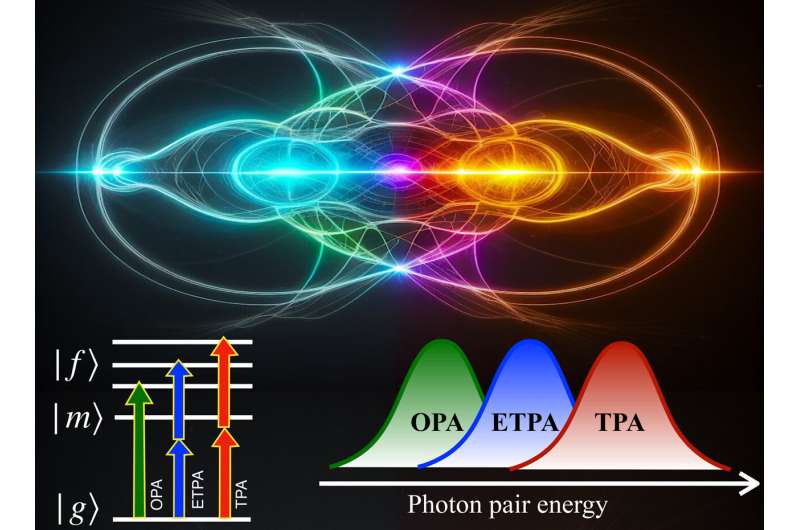This article has been reviewed according to Science X's editorial process and policies. Editors have highlighted the following attributes while ensuring the content's credibility:
fact-checked
peer-reviewed publication
trusted source
proofread
Seeing the color of entangled photons in molecular systems

Spectroscopy is the study of how matter absorbs and emits light and other radiation. It allows scientists to study the structure of atoms and molecules, including the energy levels of their electrons. Classical optical spectroscopy relies on the way particles of light called photons interact with matter. These classical spectroscopy techniques include one-photon absorption (OPA) and two-photon absorption (TPA).
Quantum light spectroscopy relies instead on a property of quantum mechanics called entanglement. This is an intrinsic connection between particles that means one photon cannot change without the other also changing, no matter how far apart they are. Recent research has examined a quantum light spectroscopy technique called entangled two-photon absorption (ETPA) that takes advantage of entanglement to reveal the structures of molecules and how ETPA acts at ultrafast speeds to determine properties that can't be seen with classical spectroscopy.
The findings are published in the journal Proceedings of the National Academy of Sciences.
This research demonstrated that ETPA can obtain different information about molecules than OPA and TPA techniques can obtain. EPTA appears to be more efficient and to operate under lower photon intensity. This will allow scientists to use non-classical light to study states of molecules that are fundamentally different compared to states they can study with classical light techniques.
Scientists have often assumed that the colors of two-photon absorption from quantum light and classical light are the same. In this study, researchers from the University of Michigan and Northwestern University revealed through a combined experimental and theoretical study of an important organic molecule, zinc tetraphenyl porphyrin, that the colors of entangled two-photon absorption are remarkably different from the corresponding classical counterpart and also from one-photon resonant absorption with photons of doubled frequency.
This is due to the involvement of distinct electronic excited states. The results show that the most important excited states for both classical and quantum light excitation possess high electronic entanglements. The results also show that ETPA provides the opportunity to probe molecules with non-classical light that are inaccessible with classical light or to enhance their quantum light response under extremely low excitation intensity.
ETPA may be particularly useful for solving the long-standing challenge of photodamage and phototoxicity in bioimaging, especially in complex biological molecules. This would expand researchers' ability to conduct non-destructive imaging of complex biomolecules. Of particular interest is the implementation of the ETPA imaging modality to monitor long-term spatial and temporal dynamics of bacterial gene expression in the sub-soil rhizosphere. In addition, identifying the colors of such an entangled two-photon absorption could lead to reduction in data acquisition time while maintaining an extremely low excitation intensity.
More information: Oleg Varnavski et al, Colors of entangled two-photon absorption, Proceedings of the National Academy of Sciences (2023). DOI: 10.1073/pnas.2307719120
Journal information: Proceedings of the National Academy of Sciences
Provided by US Department of Energy



















